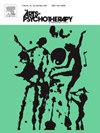Art therapist’s interventions in terms of the potential space in an open studio for at-risk children: Vignette analyses
IF 1.5
3区 心理学
Q3 PSYCHOLOGY, CLINICAL
引用次数: 0
Abstract
This study explored therapeutic interventions of art therapists working with at-risk, six to ten-year-old foster care children. The exploration was conducted with Winnicott’s concept of potential space in mind; this space may be impaired in children who have suffered trauma and neglect. Three experienced art therapists conducted a reflexive thematic analysis of 27 vignettes documenting interactions between child, therapist, and artwork/materials, with special focus on intervention characteristics and children's responses. The findings reveal four types of therapeutic interventions relating to the potential space: a) Encouraging entry into the potential space; b) Joining the potential space; c) Disrupting the potential space; and d) Failure to facilitate entry into the potential space. The challenge of identifying the potential space in some vignettes is also addressed. The discussion reviews the findings through the lens of relevant psychodynamic theories, particularly object relations, while considering the unique characteristics of this population. Limitations of this study, therapeutic implications, and recommendations for future research are also presented.
艺术治疗师在开放式工作室中对高危儿童的潜在空间的干预:Vignette分析
本研究探讨艺术治疗师对六至十岁寄养儿童的治疗干预。在进行探索时,我们牢记着温尼科特的潜在空间概念;在遭受创伤和忽视的儿童中,这个空间可能会受损。三位经验丰富的艺术治疗师对27个记录儿童、治疗师和艺术品/材料之间相互作用的小插曲进行了反身性主题分析,特别关注干预特征和儿童的反应。研究结果揭示了与潜在空间相关的四种治疗干预类型:a)鼓励进入潜在空间;b)加入潜在空间;c)破坏潜在空间;d)不便于进入潜在空间。在一些小插图中识别潜在空间的挑战也得到了解决。讨论通过相关的心理动力学理论,特别是对象关系的镜头来回顾研究结果,同时考虑到这一人群的独特特征。本研究的局限性、治疗意义和对未来研究的建议也被提出。
本文章由计算机程序翻译,如有差异,请以英文原文为准。
求助全文
约1分钟内获得全文
求助全文
来源期刊

Arts in Psychotherapy
Multiple-
CiteScore
3.20
自引率
11.10%
发文量
66
期刊介绍:
The Arts in Psychotherapy is a dynamic, contemporary journal publishing evidence-based research, expert opinion, theoretical positions, and case material on a wide range of topics intersecting the fields of mental health and creative arts therapies. It is an international peer-reviewed journal publishing 5 issues annually. Papers are welcomed from researchers and practitioners in the fields of art, dance/movement, drama, music, and poetry psychotherapy, as well as expressive and creative arts therapy, neuroscience, psychiatry, education, allied health, and psychology that aim to engage high level theoretical concepts with the rigor of professional practice. The journal welcomes contributions that present new and emergent knowledge about the role of the arts in healthcare, and engage a critical discourse relevant to an international readership that can inform the development of new services and the refinement of existing policies and practices. There is no restriction on research methods and review papers are welcome. From time to time the journal publishes special issues on topics warranting a distinctive focus relevant to the stated goals and scope of the publication.
 求助内容:
求助内容: 应助结果提醒方式:
应助结果提醒方式:


